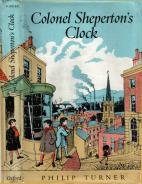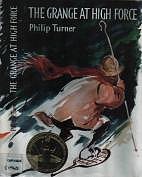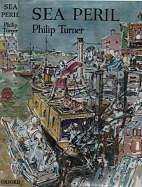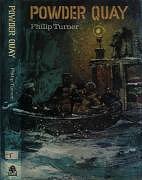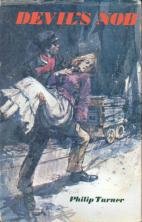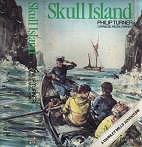| bc | Philip William Turner was born
in British Columbia in Canada on the 3rd December, 1925.
Philip William Turner was born in British Columbia in Canada on the 3rd December, 1925. He was brought to England the following year and later received his education at Hinckley Grammar School in Leicestershire and at Worcester College Oxford, receiving his B.A. degree in 1949. During the Second World War he served in the Royal Naval Volunteer Reserve from 1943-46 as a sub-lieutenant. He married Margaret Diana Samson in 1950 and was ordained a priest in the Church of England in 1951. Amongst the parishes in which he gave service were ones in Leeds, Crawley in Sussex and Northampton. During the later year of 1960s he became the Head of Religious Broadcasting for the Midland Region and then he took up teaching at Droitwich High School with later appointments as chaplain of Eton College and part-time teaching at Malvern College, Worcestershire. He won the Carnegie Prize for children's literature for his novel "The Grange at High Force" in 1966. He is best known for his "Darnley Mills" novels written under his own name but he also has written under the name Stephen Chance producing four books about the Reverend Septimus Treloar. Philip Turner passed away in 2006. Bibliography as recorded at the British Library. The "Darnley Mills" Stories (See
article below.) Septimus Treloar stories written under the
pseudonym Stephen
Chance Books for younger children Other Books Religious Work The "Darnley Mills" Stories Just where exactly in England is the countryside that surrounds the fictional town of "Darnley Mills" that is the centre of nine stories written by Philip Turner between 1964 and 1977 ? There are lots of clues scattered through each of the adventures but, in the end, the locations remain as enigmatic as they were when one reads the very first in the series. That is one problem that confronts the reader who starts to get drawn into the different narratives. Later in this brief introduction to Philip Turner some suggestions will be presented and you can make your own judgement about which places are real and which are figments of a very special imagination. The second problem is one that must be faced by all series writers - the decision that has to be faced by every writer who opts to carry forward the same set of characters from one tale to the next, and that is the dilemma of how to allow the personalities he creates to mature, and yet still retain the appeal that captured the readers in the first place. Consider the readers who come to the "Darnley Mills" books at the age of 10 in 1964. If they stuck with the author until 1977, they would be young men or young women of 23 and most would be likely to be exploring many other fields of fiction. The ten year olds of 1974, it could be argued, would not want stories that were set in the 1960s and they would be too young for the issues that are explored in the more mature books of the 1970s. And so, unless it is tremendously popular, most series (like Stephen Mogridge's 'New Forest' stories, for example) fade rapidly into the twilight zone of the second-hand bookshop and the dedicated collector reliving his or her youth. Fashions and lifestyles have changed so rapidly that a child in 2002 is highly unlikely ever to see a "Darnley Mills" story for sale. Moreover, as recent trends have shown, they are also likely to find that the early books are not available as libraries discard the previous decade's children's books and update their stock. Even as this article is being written one of nine stories "Dunkirk Summer" is completely unavailable on the second-hand book market and "Devil's Nob" would cost you in excess of £40. Even the recent critics have neglected him – Victor Watson's "The Cambridge Guide to Children's Books in English" has no entry for "Darnley Mills" or for "Philip Turner". Yet he is there on the list of Carnegie Medal winners for "The Grange at High Force", a good book but by no means his best. Let us move from the negative to the positive for, unlike many other authors who are very much to be enjoyed only when we are children, Philip Turner has qualities that can surprise, delight and move us if we meet these books for the first time as an adult. Without giving away too much and thus spoiling the intimate bond that each good writer builds with his readers, I would like to mention a little about each book and the world of Darnley Mills. Make no mistake about it, each story is entire and complete in itself but, once having invested in world that he creates, the gradual effect of the whole series builds up your rewards like money put out at compound interest. The first thing to make clear is that there are two cycles of stories. Five books concern the lives of David, Peter and Arthur, boys who grow up in the 1960s and 70s contemporary with the first set of readers for whom Philip Turner began writing. The remaining four books are part of a historical cycle which begins with two stories about Darnley Mills at the time of the Industrial Revolution, continues with a First World War adventure and ends with the momentous events of 1940, including Dunkirk and the Battle of Britain. For the sake of convenience from this point onwards I will call them "The Modern Cycle" and "The Historical Cycle". By far the best way to read them for the first time is to follow the order in which they were written, swapping between the past and the present as each story is told. Therefore that is the way in which they will be presented here.
The Grange
at High Force (Modern Cycle) (Carnegie Medal
Winner)
Sea Peril (Modern
Cycle)
However, the old lady has not taken into account the resourcefulness of her grand-daughter, Lady Jane, and the firmness of her friendship with Peter, David and Arthur. Only the little girl knows that in a shed on the estate is a relic from the past that turns out to have a profound significance for David. Downstream from Darnley Mills lies the estuary and the new home of the retired Admiral. On an island the deadly rivals of our old friends lie in wait to play their part in the war between schoolboys that is about to break out. None of them can suspect that after the campaign is over the weather will change and the real danger begin. All the boys know that the time for youthful adventures will be soon over and they will have to face the real world. Devil's
Nob (Historical Cycle)
Dunkirk
Summer (Historical Cycle) Skull
Island (Modern Cycle)
Somewhere in the North-East There is a waterfall in north Yorkshire called "High Force". Is it the same waterfall in the Darnley Mills stories ? That would make the River Darnel of the stories the River Tees in reality. Are there enough slow loops and meanders in the Tees to suggest the river that flows past Bridgebolton Manor ? Other clues that can be followed are even more puzzling. In "Sea Peril" we learn that High Force is eleven Roman signal stations to York in one direction and twelve to the Roman Wall in the other. In "Dunkirk Summer" the German raiders have the three industrial areas to pick on – the River Tyne and Newcastle, the River Wear and Sunderland and finally the area around the estuary leading up to Darnley Mills. This surely makes it the River Tees. So where is the town of Darnley Mills ? Is it Stockton ? Have I picked the wrong valley and it is really all about the Esk which flows into the sea at Whitby ? There are suggestions of Barnard Castle in some of the descriptions and Darlington is mentioned as the place where Arthur Ramsgill is spending his time at agricultural college. After all Stockton and Darlington are appropriate places to set a story like "Steam on the Line" which is partly about the early days of the railway. Yet one thing we do know for certain is that the railway descriptions in that story are based on the Festiniog Railway in Wales. Perhaps this transplanted Welsh railway system is, after all, our best clue as to where the real landscape of Darnley Mills lies – it lies in the imagination of the author and of his readers. The places and landscapes I have mentioned are no more than mere hints about the "truth".# |
bc |
